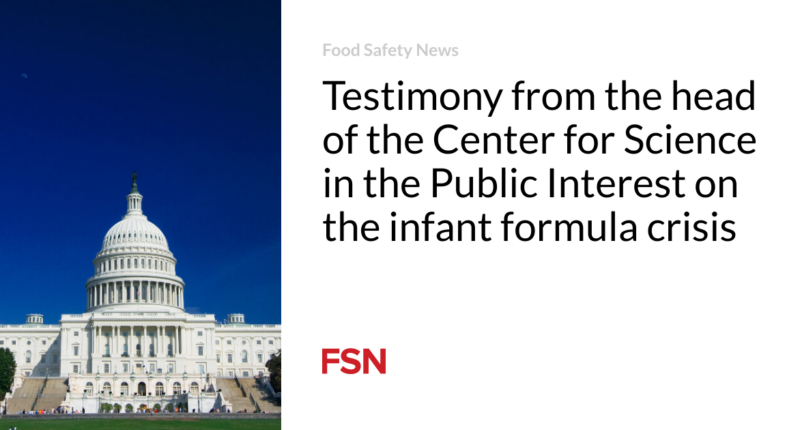The US infant formula crisis could have been prevented if there was more competition in the market. The Abbott Nutrition plant in Sturgis, MI, which produced contaminated infant formula, was estimated to control about 40% of the US formula market. Market concentration is one of the factors behind the ongoing drug shortage problem as well. Despite the FDA response being appropriate, there were shortcomings. The agency failed to deliver a whistleblower report to senior agency staff for months, and they took too long to schedule a repeat inspection of the Sturgis facility, delaying the recall. Better prevention and management of future crises require authority, funding, and an effective organizational structure. The Food and Drug Omnibus Reform Act provided the FDA with some additional authorities, but they require more. Lastly, Americans deserve a food program that is transparent, effective, and accountable. The reorganization plan announced by FDA Commissioner Robert Califf on January 31, 2023, is an important step on the path towards addressing these issues.
Infant Formula Crisis: Testimony from CSPI’s Peter Lurie Before the U.S. House of Representatives Committee
Peter Lurie, MD, MPH, President and Executive Director of the Center for Science in the Public Interest (CSPI), testified before the U.S. House of Representatives Committee on Oversight and Accountability Subcommittee on Health Care and Financial Services. In his testimony, Lurie discussed the infant formula crisis that plagued the US market in recent years.
CSPI is a non-profit advocacy group that has been monitoring food and health issues on behalf of US consumers for over 50 years. Lurie, a former Associate Commissioner at the Food and Drug Administration (FDA), worked on drug shortages during his tenure. He drew parallels between the powdered infant formula shortage situation and drug shortages.
Lurie attributed the root cause of the infant formula crisis to the Abbott Nutrition plant in Sturgis, MI. The formula produced at the plant was contaminated with Cronobacter sakazakii, which resulted in an outbreak tied to four hospitalizations and two deaths. The contaminated formula was destroyed years before the outbreak without notifying the FDA. A whistleblower also reported lax cleaning practices, falsified records, and relevant information hidden from FDA inspectors at the plant.
Repeated FDA inspections at the Abbott Nutrition plant revealed standing water, decaying dryers, failure to follow sanitary practices, and multiple environmental samples on medium- and high-care areas that tested positive for Cronobacter sakazakii. Although the outbreak strain was not among the environmental strains FDA detected, these conditions, the increasing numbers of cases, and the deadly nature of Cronobacter infection compelled the FDA to demand a product recall.
Lurie commended the FDA’s efforts to address the crisis, but he also pointed out that the crisis could have been prevented if the Abbott Nutrition plant had adhered to the necessary sanitary practices and had been transparent with the FDA. He urged the FDA to strengthen its regulatory oversight to prevent similar crises from occurring in the future.
Overall, Lurie’s testimony shed light on the serious implications of the infant formula crisis and the need for more stringent regulatory measures to ensure public safety.
Factors Contributing to the U.S. Infant Formula Crisis and Improvements Needed in the FDA’s Response
The U.S. infant formula market faced a full-blown shortage following the recall of Abbott formula, largely due to market concentration. Prior to the recall, Abbott controlled 40% of the market, with approximately half of that coming from its Sturgis plant. Furthermore, only four companies controlled 90% of the domestic market, leaving few alternative suppliers as the recall hit. This situation existed for years, but the pandemic, Abbott Nutrition’s deficient manufacturing practices, and the war in Ukraine combined to produce a shortage.
Although the FDA’s response to the crisis was largely appropriate and drew from its drug shortage experience, some aspects fell short of American consumers’ expectations. A whistleblower report went undelivered to senior agency staff for months, and the agency took too long to schedule a repeat inspection of the Sturgis facility, delaying the recall as Cronobacter sakazakii cases continued to be reported. While the agency ordered an internal review of its response, the report failed to provide a clear account of the events surrounding the recall or the mistakes made by agency officials.
To prevent and manage future crises, the FDA must have authority, funding, and an effective organizational structure. The agency should improve regulatory oversight to prevent similar crises from occurring in the future, and the government should ensure that the FDA has adequate funding to carry out its responsibilities.
The FDA also took several measures to address the crisis, such as convening an Agency-wide Incident Management Group, identifying alternative suppliers that could increase production, and facilitating the importation of products from abroad. However, some aspects of the FDA’s response, such as delayed delivery of a whistleblower report, were suboptimal.
Overall, the U.S. infant formula crisis highlighted the need for a more competitive market, better manufacturing practices, and a more effective and transparent response from the FDA. With these improvements, future crises can be prevented or managed effectively.
The Food and Drug Omnibus Reform Act provided the FDA with additional authorities to protect the U.S. infant formula supply. Formula and medical food manufacturers were required to develop a redundancy risk management plan, and an Office of Critical Foods was created to manage the regulation of infant formula and medical foods. The act also required critical food manufacturers to notify the FDA of interruptions in manufacturing that could cause meaningful disruptions in supply.
Despite these measures, the FDA needs more authority to better protect U.S. infants. The agency should have the authority to require manufacturers to notify the agency of positive test results for relevant pathogens and to mandate more frequent environmental testing in production facilities. Additionally, the FDA should have the authority to compel manufacturers to submit supply chain data, enabling the agency to analyze and respond to evolving issues. The Office of Critical Foods should also be able to designate additional foods in a public health emergency and require notification of potential shortages related to those foods. Finally, the Council of State and Territorial Epidemiologists and Centers for Disease Control and Prevention should add Cronobacter to its list of nationally notifiable diseases and conditions, and more states should join Minnesota and Michigan in including Cronobacter as a reportable disease.
In addition to more authority, the food program at the FDA requires more funding. The rising costs have left the food program with a number of full-time equivalents (FTEs) similar to what it had in 1978. This is despite the fact that the food industry has evolved dramatically since the 1970s, and the FDA has been given more and more responsibilities from Congress.
The President’s FY 2024 budget calls for $152 million in necessary new funding for the FDA’s food program, including support for improved oversight of infant formula and establishing a Center for Nutrition that will house the Office of Critical Foods. This funding will allow the agency to hire 195 additional FTEs. However, CSPI believes that the number dedicated to nutrition in the President’s budget is too small and that a figure closer to $24 million is needed to adequately fund this important work.
Adequately funding the food program is critical to ensuring an optimal infant formula supply. With additional authority and funding, the FDA can better protect U.S. infants from potential supply chain disruptions and ensure that formula manufacturers adhere to the necessary safety standards.
A recent infant formula crisis has caused a full-blown shortage, leaving parents searching for dwindling supplies. The Abbott Nutrition plant in Sturgis, MI, which produced 40% of the US formula market, was linked to infant formula contaminated with Cronobacter sakazakii that resulted in hospitalizations and deaths. The crisis revealed the high level of dysfunction, breakdowns in communication, and lack of clear lines of authority that characterized the agency’s response.
The Center for Science in the Public Interest (CSPI) has proposed three elements to prevent and manage future crises: authority, funding, and an effective organizational structure. The Food and Drug Omnibus Reform Act gave FDA additional authorities to require formula and medical food manufacturers to develop a redundancy risk management plan, create an Office of Critical Foods at FDA to manage the regulation of infant formula and medical foods, and require critical food manufacturers to notify FDA of interruptions in manufacturing likely to lead to meaningful disruptions in supply.
To better protect infants, FDA should have the authority to require manufacturers to notify the agency of positive test results for relevant pathogens and submit supply chain data for the agency to analyze and respond to evolving issues. Additionally, the Office of Critical Foods should be able to designate additional foods in a public health emergency and require notification of potential shortages related to those foods.
Despite efforts by Congressional appropriators to boost funding for FDA’s Center for Food Safety and Applied Nutrition (CFSAN), rising costs have left the food program with a number of FTEs similar to what it had in 1978. The President’s FY 2024 budget calls for $152 million in necessary new funding for FDA’s foods program to hire 195 additional FTEs, including support for improved oversight of infant formula and nutrition. However, CSPI believes that a figure closer to $24 million is needed to fund nutrition work adequately.
The proposed reorganization plan by FDA Commissioner Robert Califf on January 31, 2023, is an important step towards addressing issues in the food program. The proposal dissolves the dysfunctional structure of senior officials with authority over the human foods program and clarifies the relationship between the human foods program and the Office of Regulatory Affairs, which inspects facilities. Additionally, the proposal creates a new Center for Excellence in Nutrition and a new Office of Critical Foods. This proposal lays a strong foundation for a newly enhanced food program at FDA, led by a more empowered and accountable leader, that can ensure a safer and healthier food supply for all.
Don’t miss interesting posts on Famousbio









